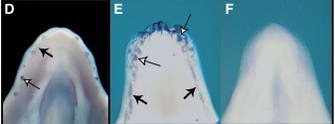« Prev Next »
Hens do not have teeth, and humans do not have tails. Research suggests we have "what it takes" for a tail, and hens, indeed, have the genes that encode for a toothy grin; however, only in very rare situations do these traits manifest themselves as a phenotype. This phenomenon is called atavism—the reappearance of a trait that had been lost during evolution. Our genes do not determine who we are, but with atavism, they can sometimes serve as reminders of our evolutionary past.
Traits that appear or disappear over time are not the result of newly mutated genes encoding defective versions of the proteins associated with teeth or tails, nor are they caused by a loss of existing genes. Instead, a growing body of experimental evidence has shown such traits reflect changes in how, where, and when these genes are expressed.
Examples of "Teeth" in Chicken

Even though birds lost teeth as physical structures between 60 and 80 million years ago, several studies have shown that those tissues within birds that would normally produce teeth still retain the potential to do so. For example, in 1821, Geoffrey St. Hilaire was the first scientist to publish the observation that some bird embryos exhibited evidence of tooth formation, but his contemporaries considered his work flawed. Since then, however, many investigators have unearthed molecular evidence that the genes involved in odontogenesis (tooth development) are indeed retained in chickens.
A primary step in reaching this conclusion occurred when researchers exposed chick jaws to certain proteins known to cue tooth development. As a result, toothlike structures grew, and other tooth markers were expressed (Chen et al., 2000). These findings were artificial in the sense that the prompting signal was experimentally administered; nonetheless, they were significant in showing that a chicken's jaw could produce teeth if specific conditions were present.
Despite this discovery, no one had yet demonstrated that chickens could develop teeth without external cues. This situation soon changed, however, when researchers Matthew Harris (a graduate student at the time) and John Fallon launched a study involving chickens with a particular kind of autosomal recessive mutation (Harris et al., 2006). These chickens, designated by the abbreviation ta2, displayed signs reminiscent of early tooth development.
The researchers needed a positive control with which to compare their hens' teeth-that is, a closely related animal in which teeth occur. Typically, the nonmutant or "wild-type" phenotype serves as a control in gene mutation experiments, but this was an exceptional case in that the wild-type chicken doesn't have teeth. Harris and Fallon specifically needed to compare the structures they believed to be teeth in their ta2 mutant chickens with the next best thing—the closest ancestor to the chicken that still has teeth—which in this case was the archosaur, otherwise known as the common crocodile. Therefore, the researchers examined the expression of several biomarkers in wild-type chicken embryos, ta2 mutant embryos, and crocodile embryos. They found that the ta2 mutant oral cavities appeared developmentally closer to those of the crocodiles than to those of their wild-type siblings. These results thus demonstrated that all the genetic pieces to the tooth-building puzzle exist in chickens, but the directions have evolved to tell those pieces to do something different over the last 80 million years.
Atavism and Human Tails
True examples of atavism, like the ta2 chicken, are data points indicative of common ancestry between species. In the case of human beings, the presence of a tail is a striking example of such ancestry. Many cases of people born with "tails" exist in the medical literature, but it is not always clear whether these appendages are "true" tails or not. In some instances, they are actually "pseudotails," or malformations that just happen to be located near a person's tailbone. True tails, however, result from a particular type of error during fetal development.
In order to understand this error, it's first important to note that all humans briefly possess tails while in the uterus. Specifically, during normal development, certain fetal cells develop into a tail and then regress as a result of programmed cell death, or apoptosis. Investigators have identified a gene called Wnt-3a as a principal regulator of this process, at least in mice (Takada et al., 1994). Researchers have also discovered that humans indeed have an intact Wnt-3a gene, as well as other genes that have been shown to be involved in tail formation. Through gene regulation, we use these genes at different places and different times during development than those organisms that normally have tails at birth. Should this process of gene regulation somehow go wrong, however, the likelihood (albeit rare) exists that a person could indeed be born with a true tail.
Errors in Gene Regulation Can Reveal "Lost" Traits

In addition to demonstrating the evolution of gene control over tooth development, the hens' teeth study serves as an evolutionary landmark in scientific development, as National Public Radio commentator Joe Palca notes. Remember the scientists who criticized St. Hilaire early descriptions of hens' teeth? One of those critics, says Palca, "trained the scientist that trained the scientist that trained the scientist that trained the scientist that trained the scientist that trained John Fallon - the principal investigator where hens' teeth were found in the ta2 mutant." As this anecdote proves, not just organisms but scientific ideas can therefore change and evolve over the course of generations as well.
References and Recommended Reading
Chen, Y., et al. Conservation of early odontogenic signaling pathways in Aves. Proceedings of the National Academy of Sciences 97, 10044–10049 (2000) doi:10.1073/pnas.160245097
Harris, M. P., et al. The development of Archosaurian first-generation teeth in a chicken mutant. Current Biology 16, 371–377 (2006) doi:10.1016/j.cub.2005.12.047
St. Hilaire, G. Sur le system dentaire des oiseaux. Annales Generales des Sciences Physiques 8, 373–380 (1821)
Takada, S., et al. Wnt-3a regulates somite and tailbud formation in the mouse embryo. Genes and Development 8, 174–189 (1994) doi:10.1101/gad.8.2.174






























